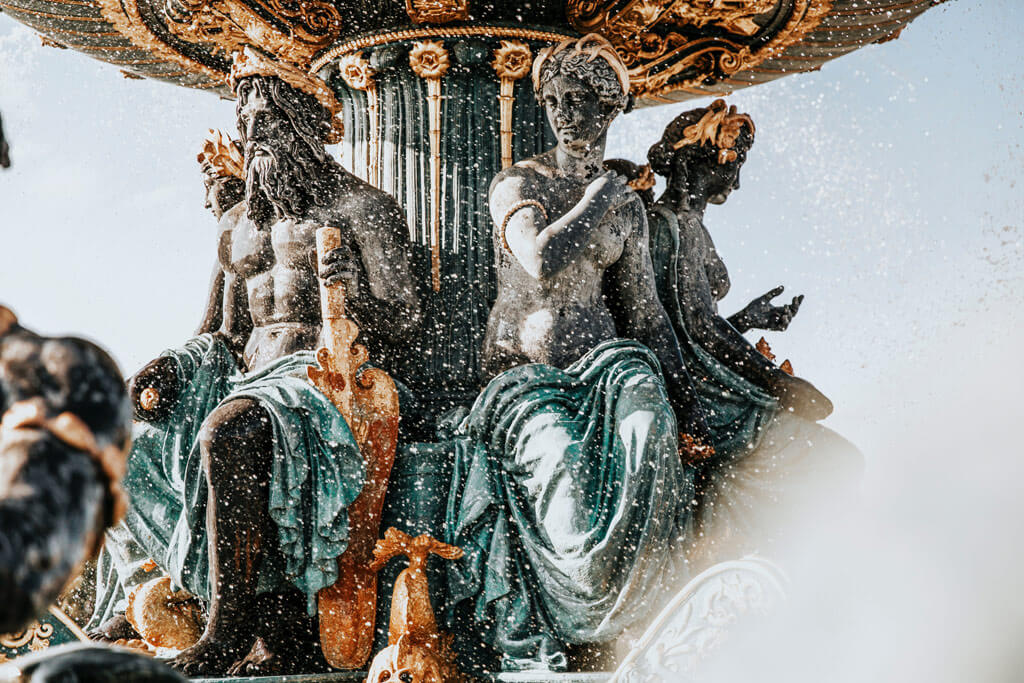
In Paris you will find squares everywhere: from tourist attractions to hidden gems, the beautiful squares of Paris (places in French) are perfect places for taking in the hustle and bustle of the city.
Amongst all the squares in Paris, 5 are Royal Squares – elegant and famous squares in Paris dedicated to a king or commissioned by him to celebrate his kingdom and victories. These 5 Royal Squares of Paris were built in the 17th and 18th centuries and they were nice places for a stroll, to see and to be seen.
The Royal Squares in Paris are very easy to recognize: a geometric plan surrounded by regular and symmetrical facades used as a background for the royal statue.
Symbol of royal power, the Royal Squares in Paris – and especially the statues that decorated them – were also the first victims of the French Revolution.
Here’s the list of the 5 Royal Squares in Paris, and the history (and quirky legends) behind each of them. With a well-planned Paris itinerary, a good pair of walking shoes, and a few days in the city, you can certainly visit them all!
READ MORE – French Revolution Walking Tour

Place des Vosges (1612)
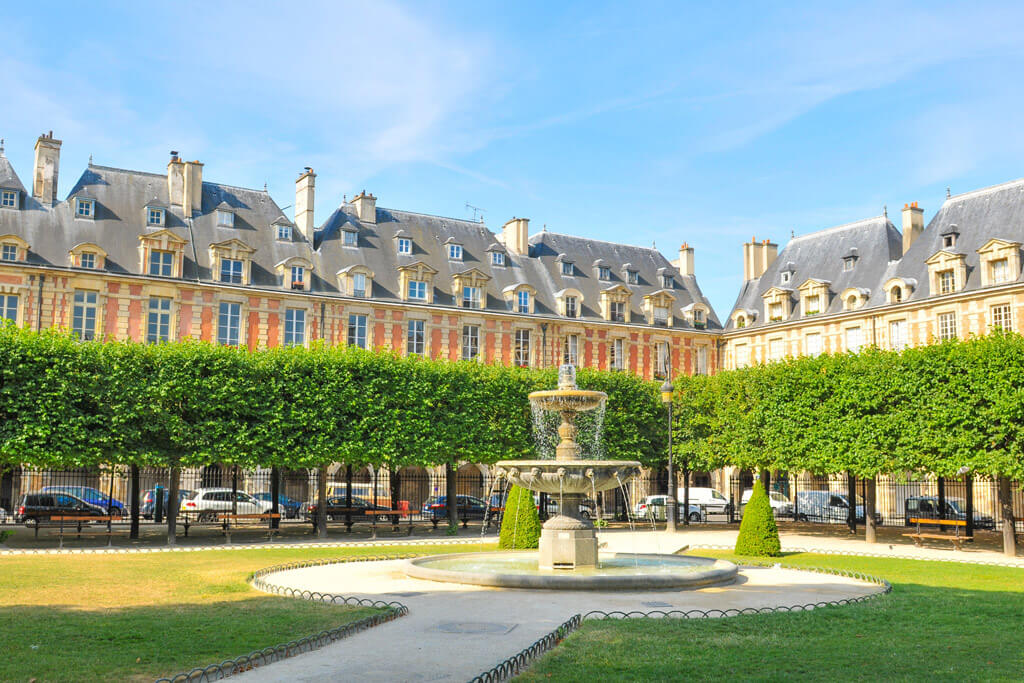
Click here for Things to Do near Place des Vosges
Place des Vosges, originally known as Place Royale, is one of the most famous squares in Paris and also the oldest. It is located in Le Marais, between Paris 4 and Paris 3.
This square was commissioned in 1605 by King Henri IV on the site of the Hotel de Tournelles and its gardens but it was inaugurated by his successor King Louis XIII.
Hotel de Tournelles was one of the most beautiful residences of the Kings of France. At a tournament near the Tournelles, King Henri II was wounded and died in this residence. After this tragedy, King Henri’s wife Cathérine de Médicis had the royal complex demolished, and she moved to the Louvre Palace.
A perfect square 140 m x 140 m, it embodied the first European program of royal city planning. Made of 36 identical elegant buildings, only the Pavillon du Roi (Saint-Antoine side) and the Pavillon de la Reine (opposite) are different. Le Pavillon de la Reine is today one of the best hotels in Le Marais and we always recommend it.
In 1,800 the square was renamed Place des Vosges, in honor of the first French department to pay its taxes. In the center of the square, you can find the Louis XIII Square with the equestrian statue of King Louis XIII. Around the square, the buildings are connected by a continuous arcade that houses small cafes and shops.
Today Place des Vosges is a fashionable place to live but also a place for all to walk and meet. You can also enjoy a Parisian picnic in the shade of the trees in the landscaped garden.
Place Dauphine (1614)
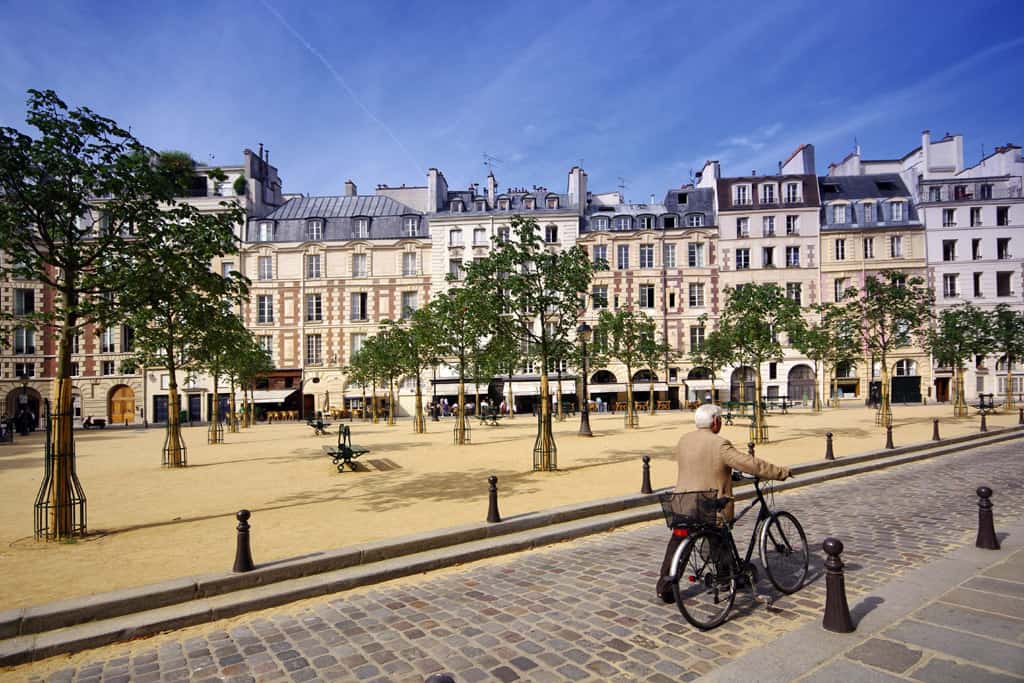
Click here for Things to Do near Place Dauphine
Place Dauphine is located on the western tip of Ile de la Cité, in Paris 1, and it is called Dauphine in honor of the Dauphin of France, King Henri IV’s son and future King Louis XIII. With an interesting design and history, Place Dauphine is definitely the most particular Royal Square in Paris.
The square is set up on the site of three alluvial islets: the islet of Passeur-aux-Vaches (or “Île aux Bœufs”), the Île du Patriarche (also called “islet of Gourdaine” ), and the Jewish Island. It was on the latter that Jacques de Molay, Grand Master of the Templars, was burned on 11 March 1314.
The construction of the Pont Neuf from 1578 to 1607 led to the reunification of the islets and their connection to the Ile de la Cité. It was then when King Henry IV the idea of creating a residential square on the site of the islets and the king’s orchard.
The square has the shape of a triangle and it is surrounded by elegant 2-story houses with the ground floor housing shops. Here, there’s no central royal statue, you need to walk to Pont-Neuf to see the equestrian statue of King Henri IV, watching the square and the world going by from afar.
The construction of this square was a success. Close to the Louvre Palace, Place Dauphine became a place of exchange and stock exchange, attracting goldsmiths, engravers, and glasses manufacturers.
Today Place Dauphine is a beautiful and quiet square to sit and relax for a while and it is common to see people playing pétanque. There are also two small restaurants good for a quick lunch and they all have tables to eat outside on the square.
THE LEGEND BEHIND THE STATUE OF KING HENRI IV
The Statue of King Henri IV (assassinated in 1610) was commissioned by the Queen-widow Marie de Médicis. Made in Italy, the statue had a difficult journey to Paris, with a shipwreck off the coast of Sardinia included. Finally, it was inaugurated in 1614 in the presence of little Louis XIII. Later, the statue was surrounded by 4 slaves, added by the sculptor Bordoni.
During the French Revolution, the statue was knocked down and the 4 slaves were moved to the Louvre Museum.
The current statue (1818) was commissioned by King Louis XVIII and it is inspired by the first one. Bronze for the new statue was obtained from the cast bronze of the statue of Napoleon I on the top of the Vendôme column, and two more statues.
The legend says that the chaser, offended by these outrages, took revenge in his own way. He stuffed the belly of the new statue’s horse with documents, songs, and other anti-royalist pamphlets, then put a statuette of Napoleon inside the right arm of King Henri IV.
Place des Victoires (1686)
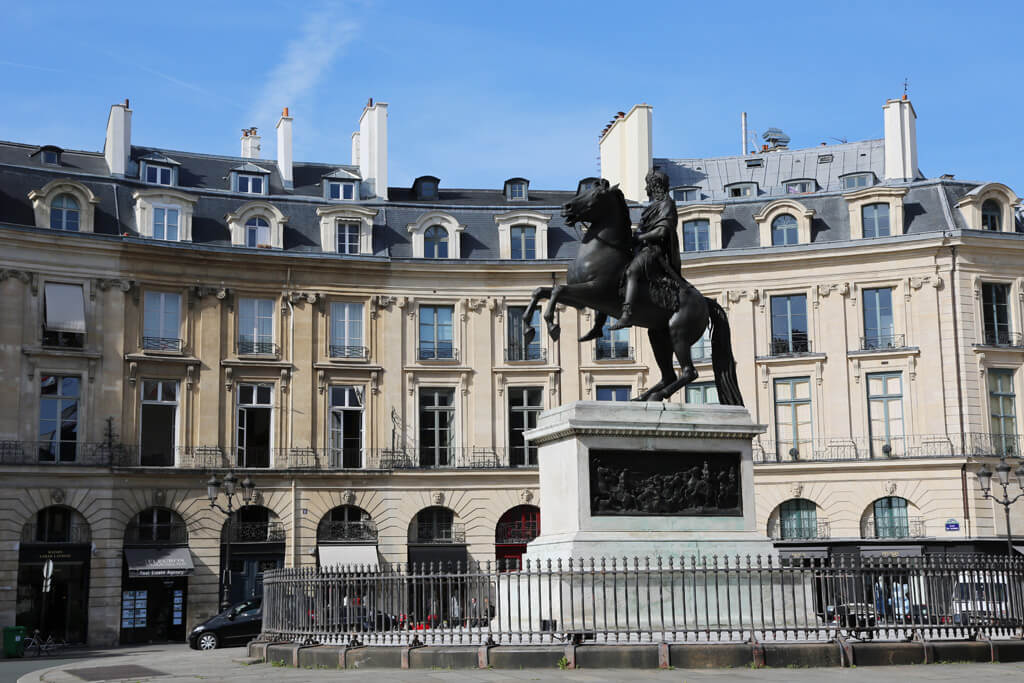
Click here for Things to Do near Place des Victoires
This is one of the lesser-known Royal Squares in Paris. It was built in honor of King Louis XIV has the particularity of being located half side in Paris 1 and the other half in Paris 2. It is a circular square with an equestrian statue of Louis XIV in its center and lined with classic buildings and upscale stores.
Place des Victoires was commissioned by the Duke de la Feuillade to celebrate the end of the Dutch War and the victory of the French army. To symbolize the superiority of the Kingdom of France, the first statue at Place des Victoires was a walking figure of King Louis XIV crown by Victory and surrounded by 4 unchained slaves.
The statue was destroyed during the French Revolution in 1792, while the slaves were sent to the Louvre (again!).
After King Louis XIV, the square was decorated with a wooden pyramid and later with a sculpture of Desaix, one of Napoleon’s companions who died at the battle of Marengo.
The current statue dates from 1822 and shows King Louis XIV on horseback, dressed as a Roman emperor, and wearing a wig.
Today this is a calm place, and despite its central location is not much frequented by tourists or locals.
Place Vendôme (1699)
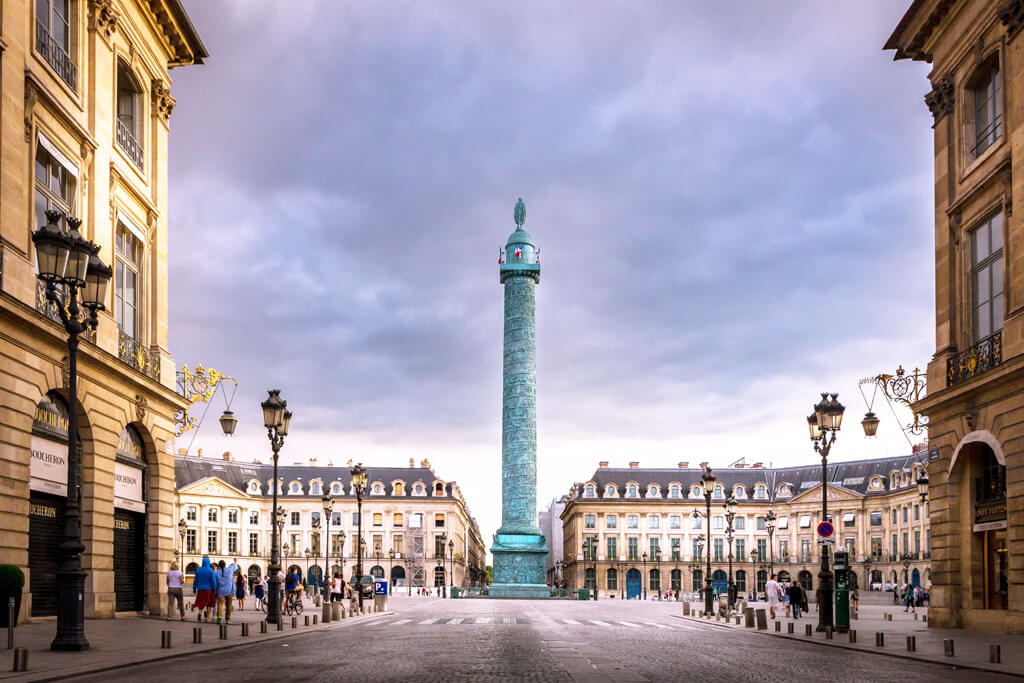
Click here for Things to Do near Place Venôme
Located in the 1st district of Paris, north of the Tuileries Gardens, Place Vendôme is home to the Ritz Hotel, the former Embassy of the Republic of Texas, and many luxury jewelry shops. The square takes its current name from Hôtel Vendôme, a private mansion located in this square.
Place Vendôme was commissioned by King Louis XIV, who wanted to air this area of Paris dominated by old, narrow streets. This large square was designed to be surrounded by a dozen public buildings but this Pharaonic project was too expensive and it was abandoned. The public buildings were replaced by the luxurious private mansions with rigorously identical facades that we know today.
Originally called Place Louis le Grand, then Place des Conquêtes (Conquest square), during the French Revolution it was named Place des Piques (pikes square) since revolutionaries marched proudly around the square with heads over their pikes! It is from the balcony of what is now the Ministry of Justice that the First French Republic was proclaimed.
THE STATUES OF PLACE VENDÔME
Since its construction, Place Vendôme has seen 5 different statues:
The first statue in the center of the square was an equestrian statue of King Louis XIV, but it was destroyed in 1792.
In 1810 the statue was replaced by the Vendôme Column, an imitation of Trajan’s Column in Rome, and covered with a screed cast with bronze cannons seized from Russian and Austrian armies. The Vendôme Column featured Napoleon I represented as a Roman emperor.
Under the Monarchy of July, the statue was replaced by a statue of Bonaparte dressed in ‘Little Corporal’. Then in 1863, on the orders of Napoleon III, this statue was replaced by another statue similar to that of 1810.
The Vendôme Column was destroyed in 1871, during the Commune of Paris. The current statue, similar to that built by Napoleon III, represents Napoleon I as Caesar.
Place de la Concorde (1772)
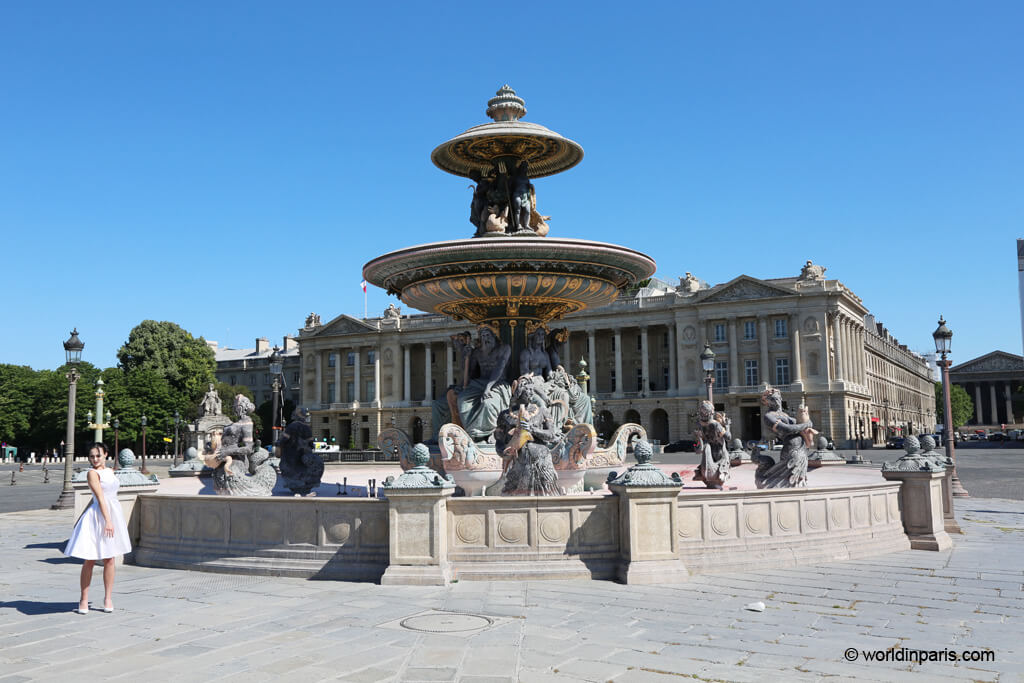
Click here for Things to Do near Place Concorde
Place de la Concorde is located in Paris 8, between the Tuileries Garden and the Champs Elysées. It is the second-largest square in France, only after Place des Quinconces in Bordeaux.
Place de la Concorde was built in 1748 at the site of a former swamp just outside the Tuileries Garden to celebrate King Louis XV’s recovery from an illness. At that time, the equestrian statue of the King dominated the vast square.
During the French Revolution, the statue was torn down and the new revolutionary government installed the guillotine. The first person to try the guillotine’s blade was King Louis XVI, King Louis XV’s grandson. Among other notable heads who shared the King’s fate, we find Queen Marie-Antoinette, Danton, Robespierre, and Camille Desmoulins.
A few months later, in 1795, the Directory decided to name the square Place de la Concorde to mark the reconciliation of the French after this bloody chapter of France’s history.
THE STATUES OF PLACE DE LA CONCORDE
The equestrian statue of King Louis XV was melted in 1792 during the French Revolution. Then named ‘Revolution Square’, the square hosted in 1793 a Statue of Liberty.
In 1835, after an arduous journey from Cairo, an obelisk from Luxor was erected in the center of the square. This obelisk was a present by the viceroy of Egypt and it became the oldest monument in Paris. The Luxor Obelisk is still visible today in the center of the square and it is part of the biggest sundial in Paris – look for the sundial marks on the pavement.

